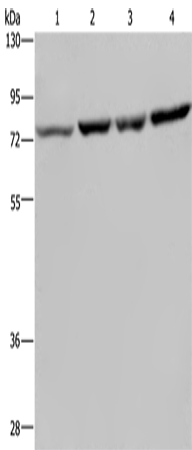
| WB | 咨询技术 | Human,Mouse,Rat |
| IF | 咨询技术 | Human,Mouse,Rat |
| IHC | 咨询技术 | Human,Mouse,Rat |
| ICC | 技术咨询 | Human,Mouse,Rat |
| FCM | 咨询技术 | Human,Mouse,Rat |
| Elisa | 1/2000-1/5000 | Human,Mouse,Rat |
| Aliases | PAB1; PABP; PABP1; PABPC2; PABPL1 |
| WB Predicted band size | 71 kDa |
| Host/Isotype | Rabbit IgG |
| Antibody Type | Primary antibody |
| Storage | Store at 4°C short term. Aliquot and store at -20°C long term. Avoid freeze/thaw cycles. |
| Species Reactivity | Human, Mouse, Rat |
| Immunogen | Fusion protein of human PABPC1 |
| Formulation | Purified antibody in PBS with 0.05% sodium azide and 50% glycerol. |
+ +
1. **"Poly(A)-binding protein cytoplasmic 1 (PABPC1) interacts with the RNA-sensing proteins RIG-I and MDA5"**
*Author: Li et al.*
**摘要**: 研究揭示了PABPC1通过其C端结构域与RIG-I和MDA5相互作用,增强抗病毒信号通路,使用特异性抗体验证了其在先天免疫中的调控作用。
2. **"PABPC1 regulates mRNA stability and translation in colon cancer progression"**
*Author: Wang et al.*
**摘要**: 通过免疫沉淀和Western blot分析,发现PABPC1在结直肠癌中过表达,其抗体用于检测与致癌mRNA稳定性相关的蛋白互作网络,提示其作为潜在治疗靶点。
3. **"Stress granule assembly via PABPC1 phosphorylation modulates cellular adaptation to oxidative stress"**
*Author: Smith et al.*
**摘要**: 利用PABPC1抗体进行免疫荧光定位,证明氧化应激诱导的磷酸化修饰促进应激颗粒形成,调控细胞生存机制。
4. **"Structural basis for PABPC1 recognition by viral proteases during infection"**
*Author: Garcia et al.*
**摘要**: 研究解析了病毒蛋白酶切割PABPC1的分子机制,通过抗体共沉淀实验证实宿主-病原体互作界面,为抗病毒策略提供依据。
×